Mitigating Risk in Implementing Multi-Regional Trials in Multiple Sclerosis
Applied Clinical Trials
Examining the main challenges in designing and executing MS clinical trials and proposing mitigation strategies that may help alleviate these burdens.
Despite the market authorization of some 16 therapies for multiple sclerosis (MS), there is still no cure for this debilitating disease. In addition, all existing therapies pose safety issues, do not necessarily repair the damage caused by MS, may not have a robust effect on disability, and have not been proved to be effective in children, leaving significant unmet needs. MS is the most common cause of neurological disability in young adults, resulting in significant social and professional limitations for patients. Clinical trials of potential new therapies for MS have risen in number, particularly over the past decade, and are facing increased difficulties in identifying eligible patients. Many factors contribute to this issue, including the availability of approved therapies, exposure to previous therapies, and safety considerations, which together result in complex protocols that can be burdensome for patients. Yet, trials are needed if the therapeutic potential of new molecules in R&D to achieve a long-term improvement in disability is to be realized. Such compounds hold promise aimed at stopping damage to myelin and even boost remyelination. This article discusses the main challenges in implementing MS clinical trials and proposes mitigation strategies that clinicians may find helpful.
A brief introduction to MS and its therapy
MS, which is a chronic inflammatory disease of the central nervous system (CNS) that results in demyelination and axonal injury, is clinically characterized by recurrent and/or chronically progressive neurological dysfunction.1 This disease affects some 2.3 million people worldwide,2,3 around 75% of whom are women.4 It is now widely accepted that MS involves an autoimmune process, involving an abnormal response by the immune system against the myelin in the CNS.5,6
Symptoms of MS tend to appear in young patients between the ages of 20 to 40 and are quite variable depending on the location and extent of the plaques in the central nervous system. Typical early symptoms are blurry or double vision, tingling, and loss of sensation. Motor dysfunction with limb weakness and spasticity, movement incoordination, and bladder and bowel dysfunction are also common symptoms of MS.
The causes of MS are not fully understood, but this disease is believed to involve a combination of factors:
- Immunologic, involving an abnormal response of the body’s immune system that is directed against the myelin in the central nervous system.
- Environmental, including geography and, possibly, vitamin D deficiency.
- Infectious, with a potential role of viruses in triggering the auto-immune cascade.
- Genetic association with the HLA-DR2 locus.7
Four clinical courses of MS were defined as a result of a scientific consensus in 1996: relapsing-remitting MS (RRMS), secondary progressive MS (SPMS), primary progressive MS (PPMS), and progressive-relapsing MS (PRMS).8 A revision of the above clinical forms was performed in 20139 and a new phenotypic classification was recommended to include clinically isolated syndromes (CIS) and exclude relapsing progressive forms with disease sub-classification as either active or non-active (with relapse and enhancing MRI lesions/T2 enlarging lesions). This classification includes:
- Relapsing forms: CIS and RRMS
- Progressive forms: primary and secondary progressive forms
Therapeutic approaches to MS include relapse therapy, disease-modifying therapy, symptomatic therapy, alternative approaches, and rehabilitation. Tables 1, 2 and 3 provide a summary of disease modifying therapies (DMTs), both injectable and oral, prescribed in RRMS clinical forms with their mechanism of action (MOA) and most common side effects.
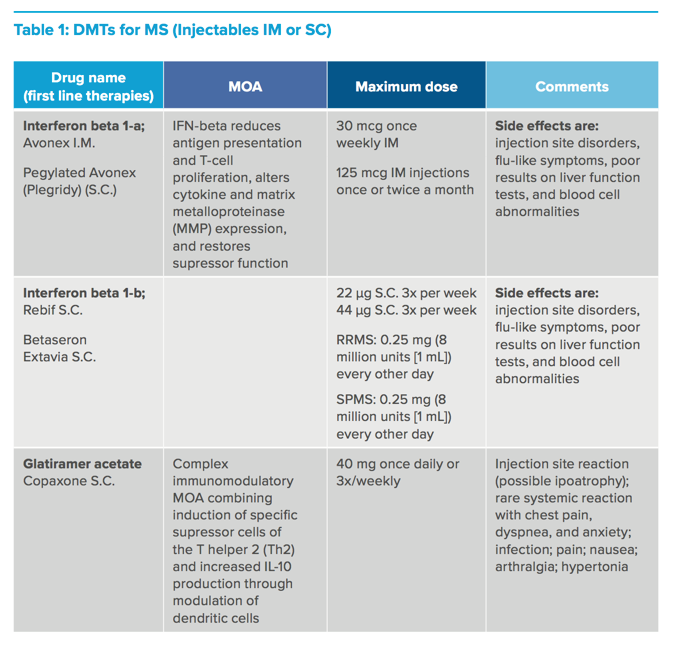
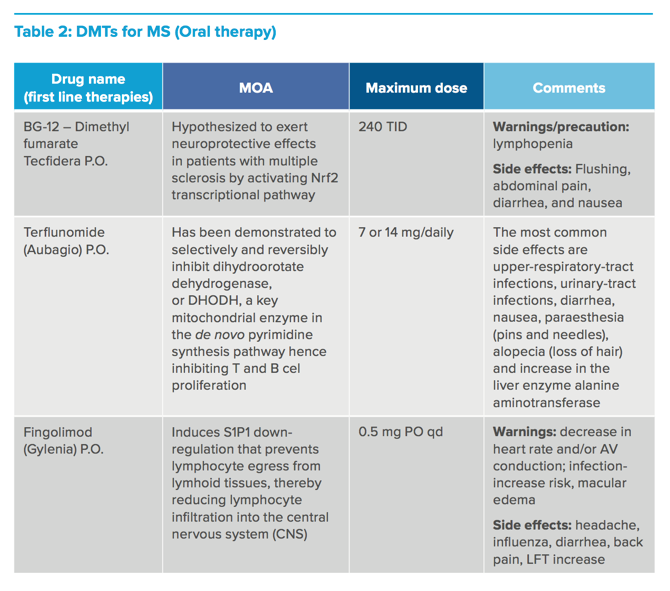
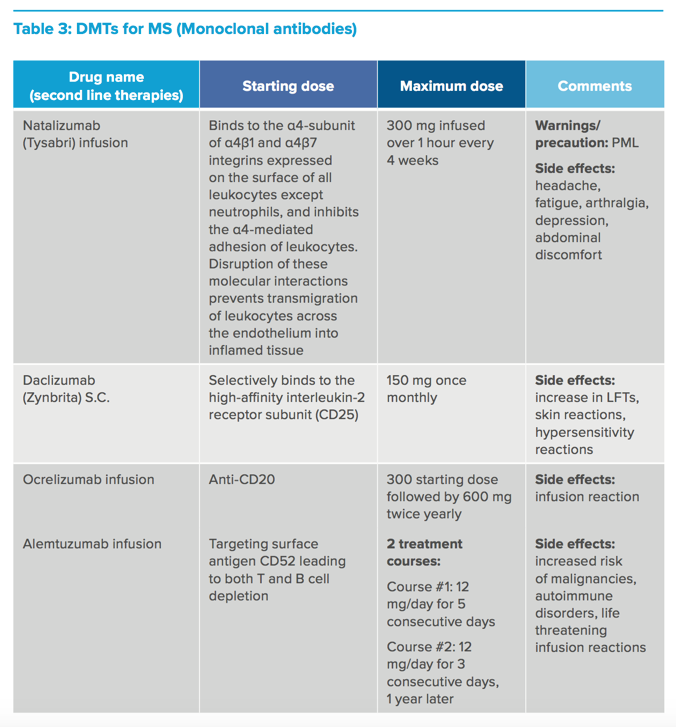
Overview of drug development in MS
Over the past two decades, 15 new therapies with a demonstrated effect on annualized relapse rate (ARR) have been approved and are available on the global market. Although most of these are injectable, since 2010, three oral therapies have been approved: Aubagio (teriflunomide), Gilenya (fingolimod), and Tecfidera (dimethyl fumarate). Of note is the May 2016 FDA approval of daclizumab for adults with relapsing forms of MS.10 In addition, the FDA has recently approved ocrelizumab11 for relapsing forms of MS and primary progressive MS.
Among major safety signals linked to MS therapies is the rare brain infection, progressive multifocal leucoencephalopathy (PML), which can have life-threatening and fatal outcomes.12 Balancing the benefit/risk ratio is, therefore, especially crucial when prescribing any therapy for MS.
A wide range of companies, from small biotech firms to large pharmaceutical companies, are developing therapies for MS. Clinical trials in this therapeutic area tend to be complex and study objectives depend on the stage of clinical development. In Phase II studies, demonstrating reduction in cerebral lesion load using magnetic resonance imaging (MRI) is considered as a standard objective. While pivotal relapsing-remitting MS (RRMS) studies typically target a decrease in the ARR, there is now increasing interest in slowing the progression of disability, and in achieving no evidence of disease activity (NEDA). Most drugs under investigation for MS target the immunological system; very few candidates (~1% of those in development) have potential as remyelinating agents. In the real-world, late-phase environment, long-term safety data is being be collected.
The major drug categories in development are shown in Figures 1 and 2 (click to enlarge).

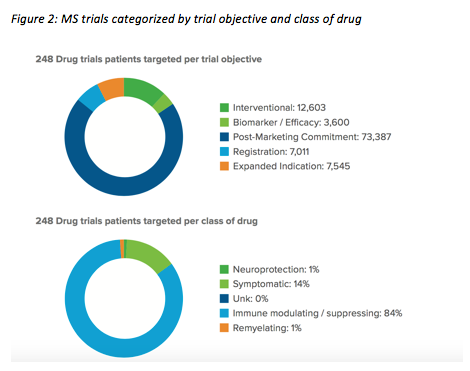
Ongoing clinical trials in MS
The landscape for MS clinical trials has become increasingly competitive in the past five years (see Figure 3), with 107,076 patients participating in almost 300 active clinical trials. Late-phase trials of marketed therapies account for 42% of all ongoing MS studies.The numbers of patients recruited to trials of various different MS drug candidates are illustrated in Figures 4 and 5.
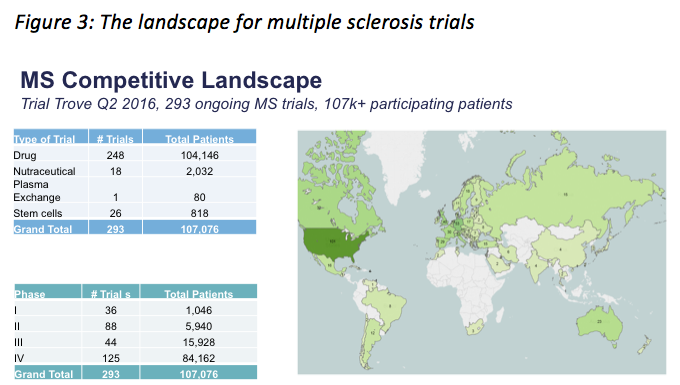
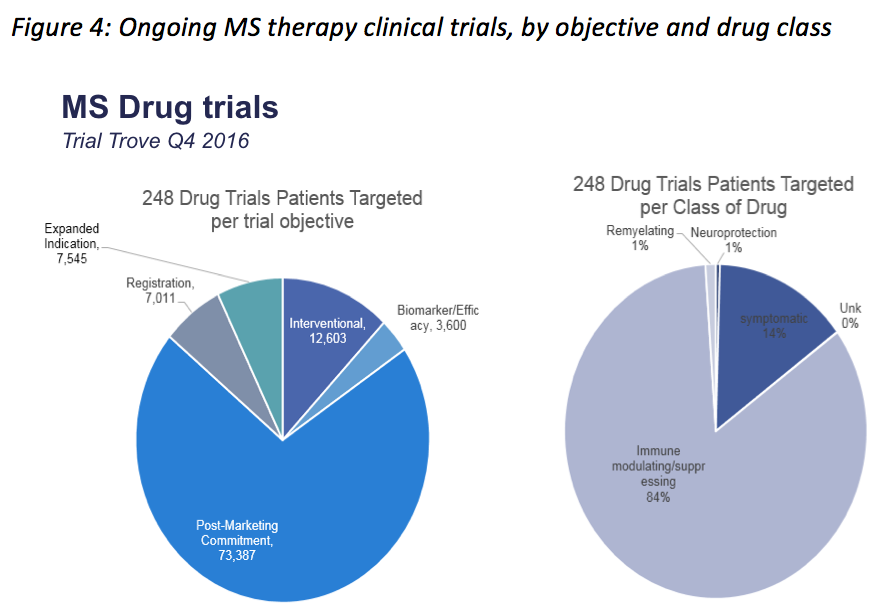
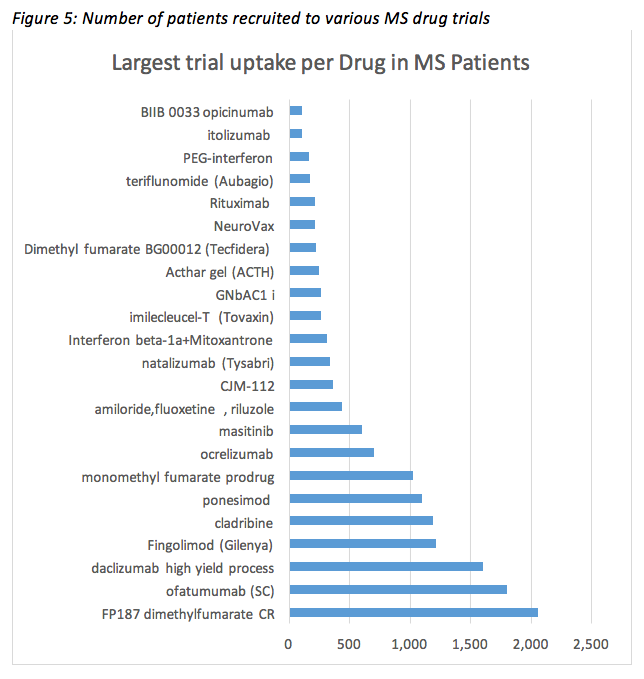
Summary of experience gained and lessons learned
Methodology
Information from the QuintilesIMS (now IQVIA) global performance database summarizing historical trial metrics were analyzed, taking into account dates of initiation and end of recruitment, to obtain the most accurate recruitment figures at a site, country, and project level. Retrospective start-up metrics reflect the time it took to bring sites in any given country to a state of readiness to begin screening patients. In addition to regulatory and institutional review board (IRB) approval times, these also include the time taken to negotiate site contracts, perform site selection visits and ensure sites are provided with all the study-related supplies. Therapeutic expertise was also applied to the above methodology, to accurately describe the current challenges observed in MS clinical trials.
Results
Based on historical data on experience with 76 MS trials performed at QuintilesIMS, involving more than 34,000 patients and 22 compounds in the last two decades, several important trends have been identified (see Figure 6 below):
- A fall in overall recruitment rates, particularly in late phase trials, and since 2012.
- A substantial increase in late-phase studies, involving the 16 therapies that have completed mid-stage development, and most of which are on the market. There is also intense activity in development of entities with a unique mechanism of action.
- Shifting recruitment to Central and Eastern Europe over the past five years, away from the traditional regions for clinical trials, such as Western Europe and North America. This shift is driven by difficult access to DMTs in Central and Eastern Europe. As a result, recruitment is also faster as patients more readily meet entry criteria relative to disease activity and limited exposure to other MS therapies.
- Decreased acceptance of placebo-controlled trials, although in some regions this is still acceptable if limited to six months or less.
Click to enlarge
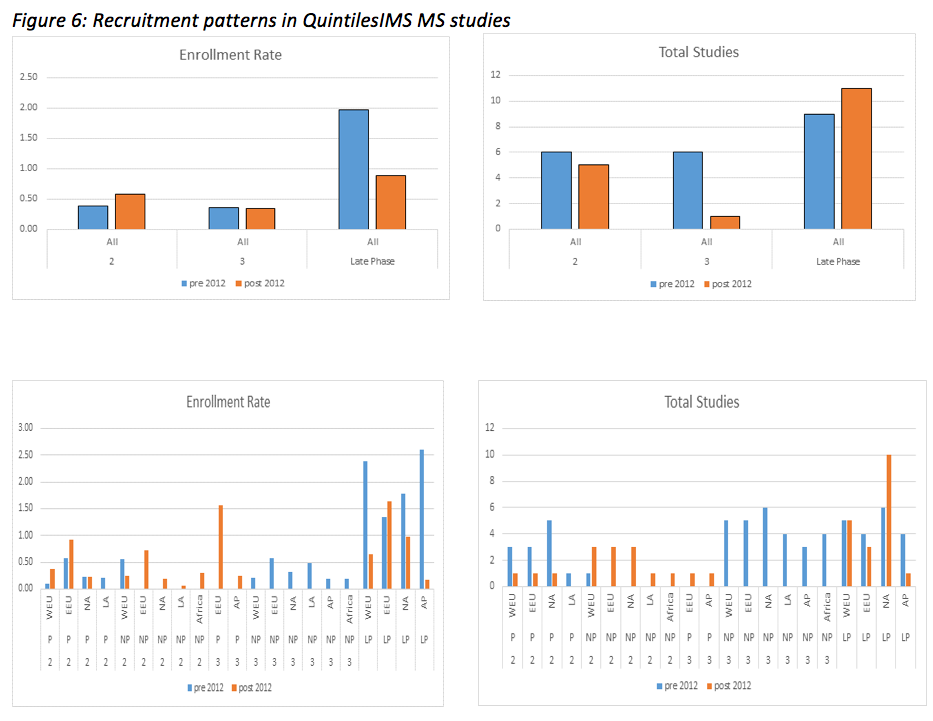
These trends are based on an analysis of the 76 clinical trials performed by QuintilesIMS between 2000 and 2016, excluding trials that were ongoing, Phase I, discontinued, or involved symptomatic therapy (gait, balance, cognition, relapse, spasticity). Of the 38 remaining studies, 10 were Phase II studies with a placebo arm (six studies) and without placebo (four studies); seven were Phase III studies, all without a placebo arm except for one study performed in Asia; and 21 were late-phase studies, of which seven were Phase IIIb, 10 wÂÂere interventional, and four were observational Phase IV studies.
Mitigation strategies
Based on QuintilesIMS experience in performing large MS programs, recruitment challenges necessitate specific mitigation plans. Several factors appear to have an effect on recruitment to MS trials, as described below.13, 14 Specific mitigations strategies that were put in place to enhance recruitment, reduce drop-out rates, and accelerate completion timelines included:
1. Protocol design and study entry criteria: Placebo-controlled studies are becoming less acceptable, even for studies with short durations. Long washout periods of previous MS therapies affects recruitment significantly. Also, there has been an overall reduction in relapse rates,15 due to previous exposure to multiple MS therapies, making it hard to find suitable study participants.
Mitigation strategies:
- Simplify protocols, and limit studies with placebo arms.
- Consider allowing first-line therapies up to the randomization visit, especially in studies of long duration.
- Anticipate the potential effect of protocol amendments on the ability to recruit “real-world” patients.
- Site selection visits (SSVs) need to be comprehensive to make sure the site has the right equipment with access to an MRI facility, resources to conduct the scales, patient-reported outcomes (PRO) training), and is fully engaged with the protocol.
2. Burden of participation for patients: This depends on the frequency and duration of clinical visits. Trials may involve invasive procedures such as lumbar punctures; if mandatory, this poses a significant hurdle for recruitment. There may be a requirement for hospitalizations or safety observation after administration of the investigational product, as well as a prolonged washout of previous therapies and prohibited medications.
Mitigation strategies:
- Simplify the study schedule and reduce the patient burden by minimizing assessments and decreasing the need for PROs, especially in early-stage development.
- Allow for optional cerebrospinal fluid collection rather than mandatory lumbar punctures.
- The relationship between the patient and site is key to retention, so tools to foster this relationship can encourage patients to stay engaged throughout the duration of the study.
- Recruitment tools should be tailored for countries and sites, and may be patient-facing (study educational materials in the form of videos, pamphlets, posters, flyers or letters from a physician to patients), site-facing (also including study educational materials and a pre-identification website), or for advertising and outreach (including digital, radio, and print media outreach; contact with MS support and advocacy groups; and local meetings).
3. The clinical form of MS involved: The RRMS arena is highly saturated and extremely competitive. Although PPMS is less saturated, the low prevalence and increasing competitive studies have a growing effect on available participants in clinical trials. Pediatric MS clinical trials are also challenging to complete, mainly because of a low prevalence and complexity inherent to this population.
Mitigation strategies:
- Select specialized high-performing centers based on previous experience (recruitment, quality), offering support with additional resources if required.
- Studies should be implemented in regions where patients have higher disease activity because of low exposure to DMTs.16
4. Therapy-related factors: These include the mechanism of action of the compound, with DMTs and remyelinating agents garnering more scientific and medical interest than symptomatic therapies; and the mode of administration, with oral formulations accepted more readily by patients than injectable ones. Other factors are the availability of approved treatment options and of alternative clinical trials with additional elements, along with availability of therapy after the study.
Mitigation strategies:
- Provide for long-term availability of investigational product, especially in countries where MS therapies are not easily available.
- Permit higher levels of participation by Eastern and Central European sites by avoiding caps on recruitment per site and per region.
- Explore new countries and regions (Asia, United Arab Emirates, Kuwait, Lebanon); even if these have a lower prevalence of disease, this is balanced by a lower exposure to clinical trials.
- Consider allowing use of certain DMTs-such as interferons-until randomization, avoiding the need for washout during the screening period, especially if the active control is an interferon.
- Provide comparator where applicable.
- Plan for targeted Investigator engagement to discuss the science and any unique mechanisms of action (MOA) of the investigational product.
Conclusion
Recruitment in MS clinical trials is becoming increasingly challenging. This was confirmed by the analysis of the trials performed at QuintilesIMS, revealing a decrease in recruitment, mainly in late-phase interventional studies. Similar trends already have been observed in other MS studies.15 Early implementation of specific mitigation plans and strategies described in the article are needed to allow study completion within predefined timelines. In addition, technological advances will be helpful, including the potential for electronic medical records (EMRs) and prescription data to be used to expedite recruitment.
Marie Trad, MD, Executive Medical Director Drug Development, Neurology Center of Excellence; Cathy Vanbelle, RN, Director, Global Strategic Drug DevelopmentCenter of Excellence, Neurology and Acute Care & Pain, Customers Solutions Management Group;Benjamin Moody, PhD, Clinical Analytics and Simulations Lead;Amy Del Medico, Therapeutic Strategy Lead, Neurology Center of Excellence; Olja Tanjga, MD, Associate Medical Director;Sam Khinda, Senior Director, Project Leadership – CNS;Lynne Hughes, BMedSci, PhD, PMP,Vice President and Head, Neurology Center of Excellence, all with QuintilesIMS (now IQVIA)
References
1. Lugaresi et al. Risk Benefit considerations in the treatment of relapsing-remitting multiple sclerosis. Neuropsychiatr Dis Treat. 2013; 9: 893–914. doi: 10.2147/NDT.S45144
2. http://www.nationalmssociety.org/What-is-MS/Who-Gets-MS
3. The atlas of MS 2013: www.atlasofms.org
4. http://www.womenshealthmatters.ca/a-question-of-health/question-of-health/multiple-sclerosis-women
5. Sospedra M, Roland M. Immunology of Multiple Sclerosis. Annu. Rev. Immunol. 2005. 23:683–747.
6. Lublin FD, Reingold SC. Defining the clinical course of multiple sclerosis: results of an international survey. National Multiple Sclerosis. Society (USA) Advisory Committee on Clinical Trials of New Agents in Multiple Sclerosis. Neurology. 1996; 46: 907–911.
7. Hoppenbrouwers I, Hintzen R. Genetics of multiple sclerosis. Biochimica et Biophysica Acta 1812 (2011) 194–201)
8. Lublin FD, Reingold SC. Defining the clinical course of multiple sclerosis: results of an international survey. National Multiple Sclerosis Society (USA) Advisory Committee on Clinical Trials of New Agents in Multiple Sclerosis. Neurology 1996; 46: 907–911. â¨
9. Lublin F. New Multiple Sclerosis Phenotypic Classification. Eur Neurol 2014;72(suppl 1):1–5 DOI: 10.1159/000367614.
10. http://www.fda.gov/NewsEvents/Newsroom/PressAnnouncements/ucm504000.htm
11. http://www.roche.com/media/store/releases/med-cor-2016-12-20.htm
12. http://www.fda.gov/Drugs/DrugSafety/ucm456919.htm
13. Campbell MK et al. Recruitment to randomised trials: strategies for trial enrollment and participation study. The STEPS study. Health Technol Assess. 2007 Nov;11(48):iii, ix-105.
14. Maida S et al. Overcoming recruitment challenges in patients with multiple sclerosis: Results from an Italian survey. Clin Trials. 2014 Dec; 11(6):667-72.
15. Kalincik T. Multiple Sclerosis Relapses: Epidemiology, Outcomes and Management. A Systematic Review. Neuroepidemiology 2015;44:199–214 DOI: 10.1159/000382130.
16. Maida S. et al. Overcoming recruitment challenges in patients with multiple sclerosis: Results from an Italian survey. Clin Trials. 2014 Dec; 11(6):667-72.
Improving Relationships and Diversifying the Site Selection Process
April 17th 2025In this episode of the Applied Clinical Trials Podcast, Liz Beatty, co-founder and chief strategy officer, Inato, discusses a number of topics around site engagement including community-based sites, the role of technology in improving site/sponsor relationships, how increased operational costs are impacting the industry, and more.
Behind the Buzz: Why Clinical Research Leaders Flock to SCOPE Summit
February 7th 2025In this episode, we meet with Micah Lieberman, Executive Conference Director for SCOPE Summit (Summit for Clinical Ops Executives) at Cambridge Innovation Institute. We will dive deep into the critical role of collaboration within the clinical research ecosystem. How do we bring together diverse stakeholders—sponsors, CROs, clinical trial tech innovators, suppliers, patients, sites, advocacy organizations, investors, and non-profits—to share best practices in trial design, program planning, innovation, and clinical operations? We’ll explore why it’s vital for thought leaders to step beyond their own organizations and learn from others, exchanging ideas that drive advancements in clinical research. Additionally, we’ll discuss the pivotal role of scientific conferences like SCOPE Summit in fostering these essential connections and collaborations, helping shape the future of clinical trials. Join us as we uncover how collective wisdom and cross-industry partnerships are transforming the landscape of clinical research.
Landmark Phase III Trial Shows Keytruda Significantly Improves Event-Free Survival in LA-HNSCC
April 28th 2025Interim KEYNOTE-689 trial data show that perioperative Keytruda significantly lowers the risk of disease progression or recurrence in resectable, locally advanced head and neck squamous cell carcinoma, marking the first major clinical advance for this patient population in more than two decades.